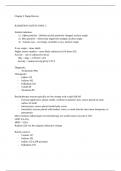Chapter 2 Nappi Review
RADIATION SAFETY PART 1:
Emitted radiation:
1) Alpha particles – (helium nuclei) positively charged, nucleus origin
2) Beta particles – (electrons) negatively charged, nucleus origin
3) Gamma rays – no charge, resemble x-rays, nucleus origin
X-ray origin – inner shells
Higher atomic number = more likely radioactive (Z# above 82)
Activity – rate of radioactive decay
1Bq = 1dps = 2.70x10^-11Ci
Activity = (initial activity)(0.5)^t/T1/2
Diagnostic:
- Technetium 99m
Therapeutic:
- Iodine-125
- Iridium-192
- Palladium-103
- Cobalt-60
- Strontium-90
Brachytherapy sources typically are low energy with a rapid fall-off
- External applicators: plastic molds, conform to patients’ skin, source placed on outer
surface of mold
- Intracavitary: source placed inside body cavity
- Interstitial: sources placed with needles, wires, or seeds directly into tumor (temporary or
permanent)
Most common radioisotopes in brachytherapy are sealed sources (except I-131)
LDR: 0.4-2Gy
HDR: >12Gy
Radium-226 was the original radioactive isotope
Brachy sources:
- Cesium-137
- Iridium-192
- Iodine-125 (LDR prostate)
- Palladium-103
, - Gold-198
Radiation therapy sources:
- Technetium (Tc99m), half-life = 6 hours
- Yttrium (Y-90), half-life = 2.67 days
- Gold (Au-198), half-life = 2.7 days
- Radon, half-life = 4 days
- Iodine (I-131), half-life = 8 days
- Palladium (Pd-103), half-life = 17 days
- Strontium (Sr-89), half-life = 50 days
- Iodine (I-125), half-life = 60 days
- Iridium (Ir-192), half-life = 74 days
- Cobalt (Co-60), half-life = 5.26 years
- Strontium (Sr-90), half-life = 28 years
- Cesium (C-137), half-life = 30 years
- Radium (Ra-226), half-life = 1,622 years
Iridium-192 is most commonly used in HDR after-loading brachytherapy
This is because it has a lower photon energy and higher specific activity
Also requires less shielding
Photon (x-ray) radiation is man-made – x-ray tube, cathode, anode, inside glass envelope
High voltage between cathode and anode produces x-rays
Cathode – negatively charged electrode with tungsten filament that releases electrons when
heated (thermionic emission)
- Tungsten Z# = 74 and melting point is 3370 Celsius
Anode – positively charged electrode also made of tungsten, known as the target
- Rotating anodes good for heat dissipation
- Hooded anode is good for preventing unwanted secondary electrons
- Targets = transmission targets in MV machine
- 1% efficiency in diagnostic (99% converted to heat)
- 30%-90% efficiency in linacs
Therapy energies = 50keV-250MeV
Orthovoltage energies = 150kV-500kV
Superficial energies = 50kV-150kV
TARGET INTERACTIONS:
1) Characteristic – inner shell interaction, inner shell electron ejected, outer shell electron
fills vacancy, kV energies
2) Bremsstrahlung – electron interaction occurs near nucleus, electron slows down and
changes direction close to the nucleus, MV and kV energies
, Bremsstrahlung X-ray production increases with atomic number
Matter Interactions:
1) Coherent (elastic) scattering: outer shell, photon changes direction/scatters from original
path without a change in energy
- Low energies (less than 10keV, high Z# material)
2) Compton scattering: outer shell, electron gives up partial energy before changing
direction
- Most common in soft tissue RT, 25keV-10MeV
- Independent of Z#
3) Photoelectric effect: inner shell, photon is absorbed by electron, energy is transferred
- Photoelectron ejected from atom, low energy photons (less than 10keV), high Z# material
- Diagnostic more than therapy ranges, creates contrast due to absorption
- Higher the energy of photon = the less chance of photoelectric effect
- Results in characteristic x-rays since outer shell electron has to fill in inner shell vacancy
4) Pair production: incoming photon disappears and reappears as an electron positron pair
- Two 0.511MeV photons, threshold needed is 1.022MeV
5) Photodisintegration (photonuclear): photon goes into nucleus and neutron comes out
- High Z# materials such as the collimating jaws
- 7-15MeV
- Neutron radiation occurs with energies higher than 10MeV
Cyclotron:
- Charged particle accelerator
- Proton therapy, speeds up protons
- Speed determines energy
- Bragg peak typically for smaller tumors and need many beams to create uniform beam
Photons have wave and particle characteristics – wave-particle duality
- No mass or charge, low LET
High LET = high RBE
High LET = less penetrating power (more energy lost quicker in material)
Low LET = low RBE
Low LET = more penetration (further distance in material)
Mayneord F factor: special application of the ISL component of PDD
- Used when there is a change in distance on an SSD setup




